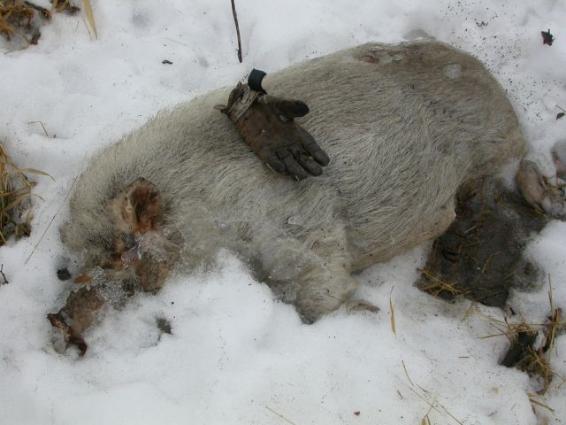Pet pigs go hog-wild in western Minnesota
| Article by: DOUG SMITH , Star Tribune | |
| Updated: March 7, 2009 - 9:43 AM |
DNR is worried about a herd of destructive pot-bellied pigs near the South Dakota border.
| Article by: DOUG SMITH , Star Tribune | |
| Updated: March 7, 2009 - 9:43 AM |
DNR is worried about a herd of destructive pot-bellied pigs near the South Dakota border.

This feral pig was shot last fall near Big Stone Lake. DNR officials say a herd of such pigs can wreak havoc on livestock and crops.
Photo: , DNR
Minnesota wildlife officials are searching the Big Stone Lake area of western Minnesota for something they hoped they'd never find: Feral pigs.
Officials recently discovered that pot-bellied pigs -- a southeast Asian species imported to the United States, often as pets -- have been roaming wild and apparently reproducing for the past few years. The pigs could number 25 to 50, and the first ones either escaped captivity or were illegally released into the wild.
"It's just really, really bad news,'' said Steve Merchant of the Department of Natural Resources. "They can be very destructive to native plants and wildlife habitat, and they carry diseases that can affect wildlife and livestock. We're definitely concerned. We want to get them out of there.''
Wildlife officials from Minnesota and South Dakota recently flew near the lake, which straddles the Minnesota-South Dakota border, searching for the pigs.
"We didn't find them,'' said Curt Vacek, DNR area wildlife manager in Appleton. The last confirmed sighting was in January when a coyote hunter reported seeing "at least two dozen'' pigs, Vacek said. He has seen the carcass of a pig killed by a deer hunter last fall and one killed by a vehicle. And he knows of four more killed in 2007.
"There was at least one young pig hit on the road, so there are indications they are breeding in the wild,'' Merchant said. "They can be prolific.''
Though officials said they only recently learned of the presence of the pigs, locals apparently have been seeing them for several years.
"The story I'm getting is these feral pigs have been reported in gardens, and a few were definitely shot last year during the deer hunting season, but I guess people didn't understand that it was a significant concern to us,'' Merchant said.
Pot-bellied pigs can grow to 300 pounds. Vacek said the carcass of one pig he examined probably weighed 90 to 100 pounds. It was a boar with 4-inch tusks.
Officials say pigs root-up vegetation, which causes erosion and other habitat destruction.
"The guy who tipped us off was a deer hunter who complained the pigs were damaging his native hill prairie,'' Merchant said. They also can damage crops, though the DNR hasn't received any complaints from farmers.
Their presence could have serious ramifications for the livestock industry, Merchant said, because pigs can carry pseudo-rabies and brucellosis.
The DNR is working with the state Board of Animal Health.
Feral pigs are found in at least 39 states and are a major problem in many of them. Once established, populations are extremely difficult to control and nearly impossible to eradicate. Some states encourage hunters to shoot them on sight.
Merchant and Vacek emphasized they don't want people to go looking for the pigs or shooting them, because that could disperse the population. They believe the pigs are congregated now, and the hope is to trap them all, then test them for disease.
Nature likely won't help. The pigs don't really have natural predators to control their population, Merchant said. Adult feral pigs can defend themselves. "A coyote would take a piglet, but I'm not sure they would mess around with an adult.''
People with information about the pigs near Big Stone Lake can call at 1-320-752-4394.